Taxation: Theory, Practice, and Law - Detailed Case Analysis
VerifiedAdded on 2023/01/11
|8
|1806
|39
Homework Assignment
AI Summary
This assignment provides a comprehensive overview of Australian taxation law, covering various aspects such as residency tests, income tax, capital gains tax, and depreciation methods. The solution analyzes several case studies, including scenarios involving residency determination based on ATO guidelines, the tax treatment of compensation for breach of contract, and the deductibility of various business expenses like legal fees, construction expenditures, and marketing costs. Furthermore, the assignment delves into depreciation calculations using both the prime cost and diminishing value methods for different assets, including machinery and vehicles. The solution references relevant legislation and regulations, demonstrating a practical understanding of tax principles.
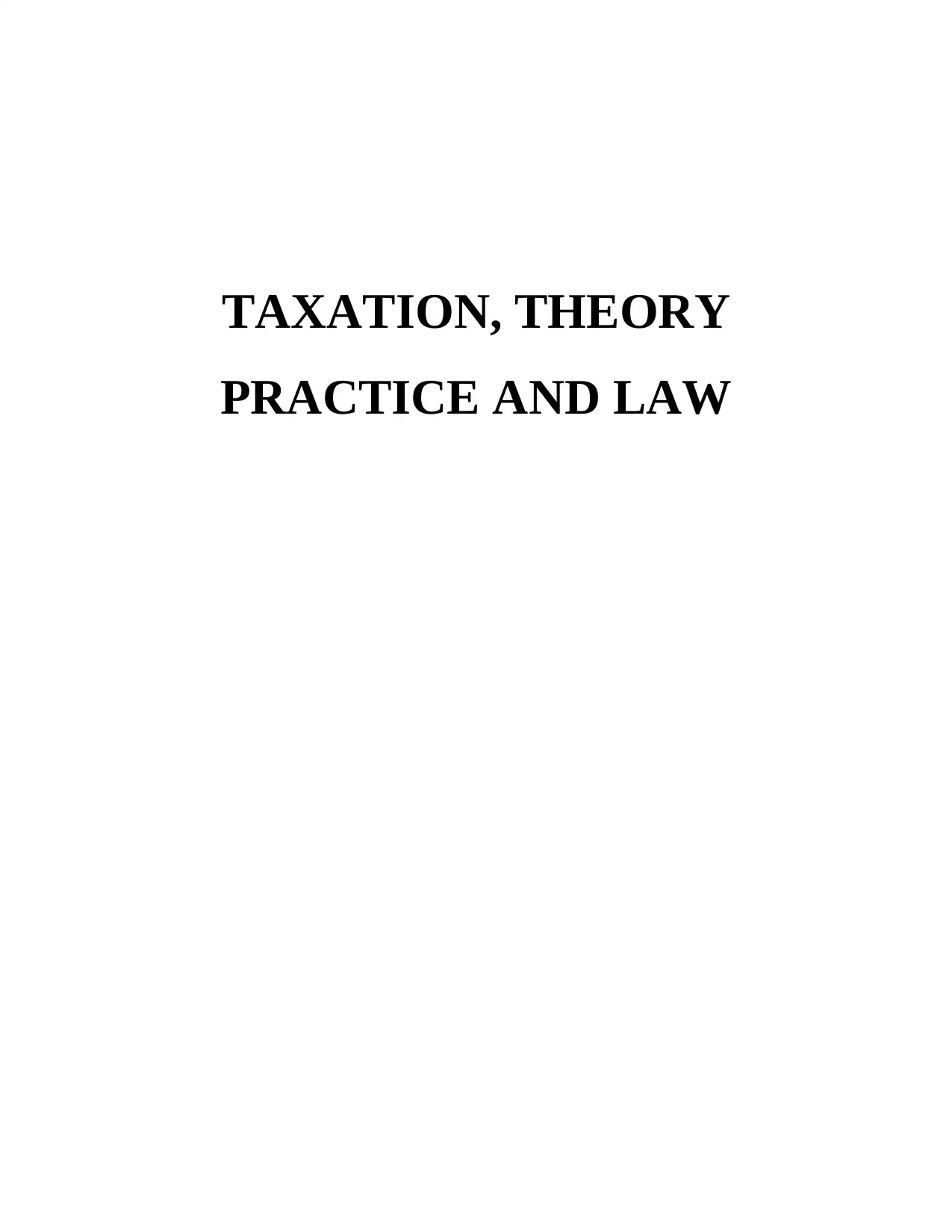
TAXATION, THEORY
PRACTICE AND LAW
PRACTICE AND LAW
Paraphrase This Document
Need a fresh take? Get an instant paraphrase of this document with our AI Paraphraser
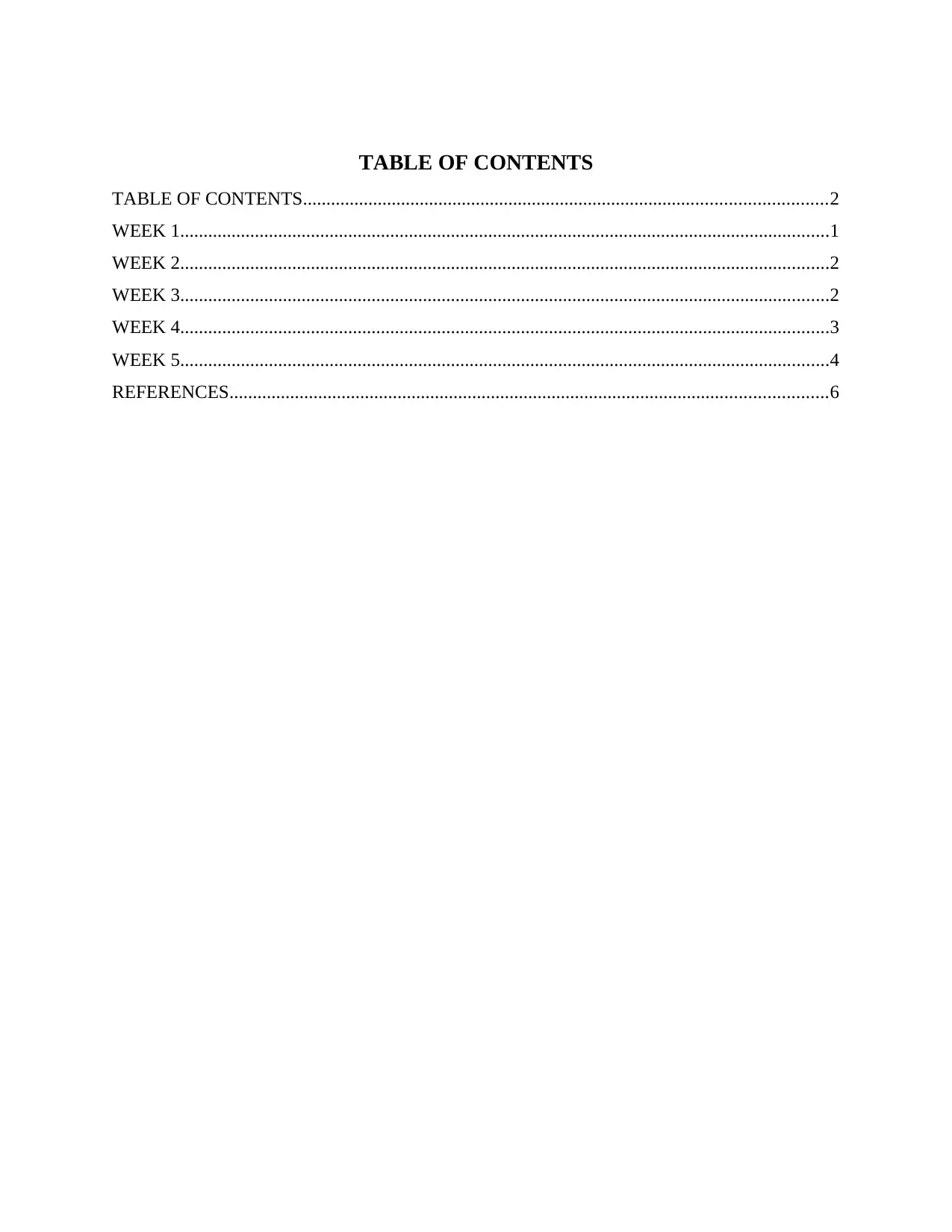
TABLE OF CONTENTS
TABLE OF CONTENTS................................................................................................................2
WEEK 1...........................................................................................................................................1
WEEK 2...........................................................................................................................................2
WEEK 3...........................................................................................................................................2
WEEK 4...........................................................................................................................................3
WEEK 5...........................................................................................................................................4
REFERENCES................................................................................................................................6
TABLE OF CONTENTS................................................................................................................2
WEEK 1...........................................................................................................................................1
WEEK 2...........................................................................................................................................2
WEEK 3...........................................................................................................................................2
WEEK 4...........................................................................................................................................3
WEEK 5...........................................................................................................................................4
REFERENCES................................................................................................................................6
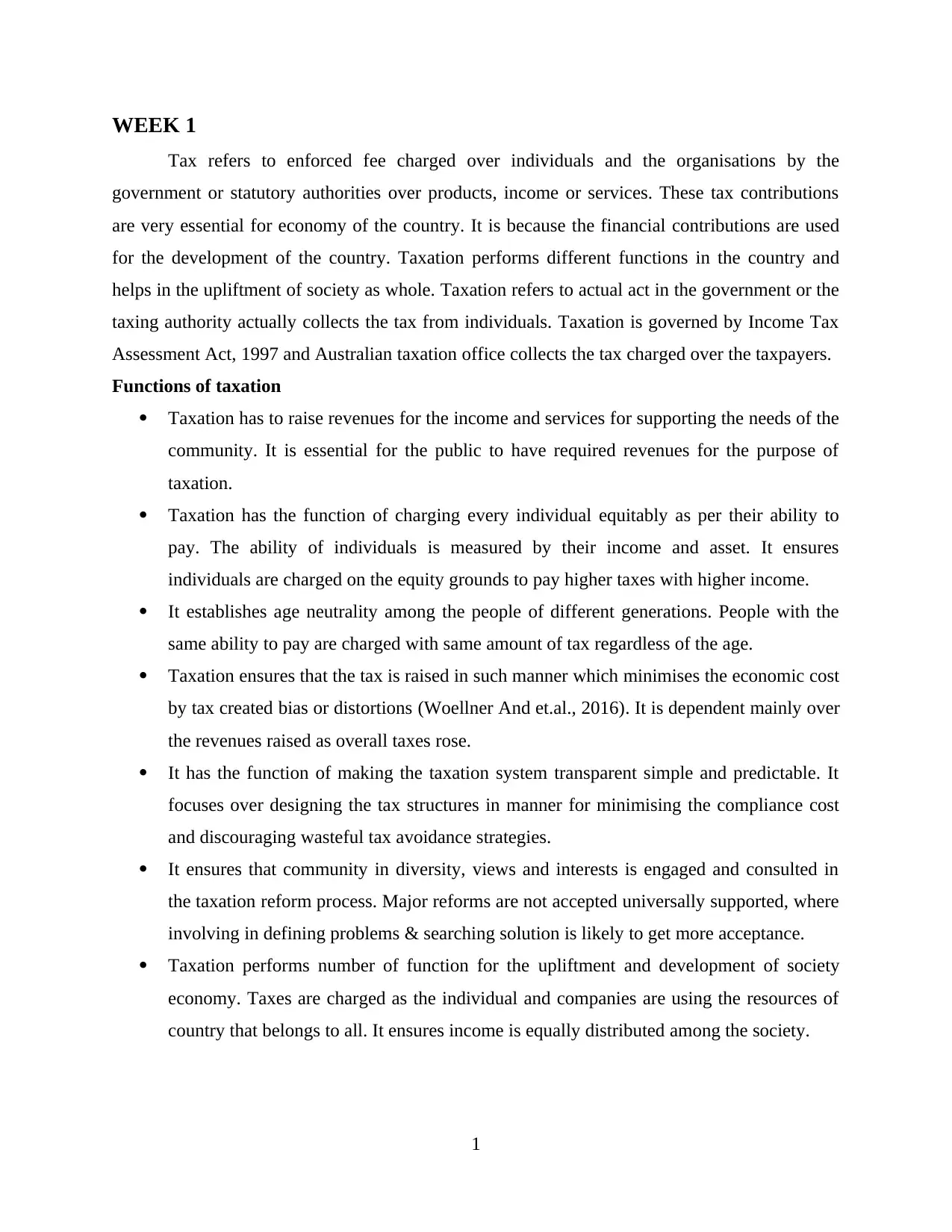
WEEK 1
Tax refers to enforced fee charged over individuals and the organisations by the
government or statutory authorities over products, income or services. These tax contributions
are very essential for economy of the country. It is because the financial contributions are used
for the development of the country. Taxation performs different functions in the country and
helps in the upliftment of society as whole. Taxation refers to actual act in the government or the
taxing authority actually collects the tax from individuals. Taxation is governed by Income Tax
Assessment Act, 1997 and Australian taxation office collects the tax charged over the taxpayers.
Functions of taxation
Taxation has to raise revenues for the income and services for supporting the needs of the
community. It is essential for the public to have required revenues for the purpose of
taxation.
Taxation has the function of charging every individual equitably as per their ability to
pay. The ability of individuals is measured by their income and asset. It ensures
individuals are charged on the equity grounds to pay higher taxes with higher income.
It establishes age neutrality among the people of different generations. People with the
same ability to pay are charged with same amount of tax regardless of the age.
Taxation ensures that the tax is raised in such manner which minimises the economic cost
by tax created bias or distortions (Woellner And et.al., 2016). It is dependent mainly over
the revenues raised as overall taxes rose.
It has the function of making the taxation system transparent simple and predictable. It
focuses over designing the tax structures in manner for minimising the compliance cost
and discouraging wasteful tax avoidance strategies.
It ensures that community in diversity, views and interests is engaged and consulted in
the taxation reform process. Major reforms are not accepted universally supported, where
involving in defining problems & searching solution is likely to get more acceptance.
Taxation performs number of function for the upliftment and development of society
economy. Taxes are charged as the individual and companies are using the resources of
country that belongs to all. It ensures income is equally distributed among the society.
1
Tax refers to enforced fee charged over individuals and the organisations by the
government or statutory authorities over products, income or services. These tax contributions
are very essential for economy of the country. It is because the financial contributions are used
for the development of the country. Taxation performs different functions in the country and
helps in the upliftment of society as whole. Taxation refers to actual act in the government or the
taxing authority actually collects the tax from individuals. Taxation is governed by Income Tax
Assessment Act, 1997 and Australian taxation office collects the tax charged over the taxpayers.
Functions of taxation
Taxation has to raise revenues for the income and services for supporting the needs of the
community. It is essential for the public to have required revenues for the purpose of
taxation.
Taxation has the function of charging every individual equitably as per their ability to
pay. The ability of individuals is measured by their income and asset. It ensures
individuals are charged on the equity grounds to pay higher taxes with higher income.
It establishes age neutrality among the people of different generations. People with the
same ability to pay are charged with same amount of tax regardless of the age.
Taxation ensures that the tax is raised in such manner which minimises the economic cost
by tax created bias or distortions (Woellner And et.al., 2016). It is dependent mainly over
the revenues raised as overall taxes rose.
It has the function of making the taxation system transparent simple and predictable. It
focuses over designing the tax structures in manner for minimising the compliance cost
and discouraging wasteful tax avoidance strategies.
It ensures that community in diversity, views and interests is engaged and consulted in
the taxation reform process. Major reforms are not accepted universally supported, where
involving in defining problems & searching solution is likely to get more acceptance.
Taxation performs number of function for the upliftment and development of society
economy. Taxes are charged as the individual and companies are using the resources of
country that belongs to all. It ensures income is equally distributed among the society.
1
⊘ This is a preview!⊘
Do you want full access?
Subscribe today to unlock all pages.

Trusted by 1+ million students worldwide
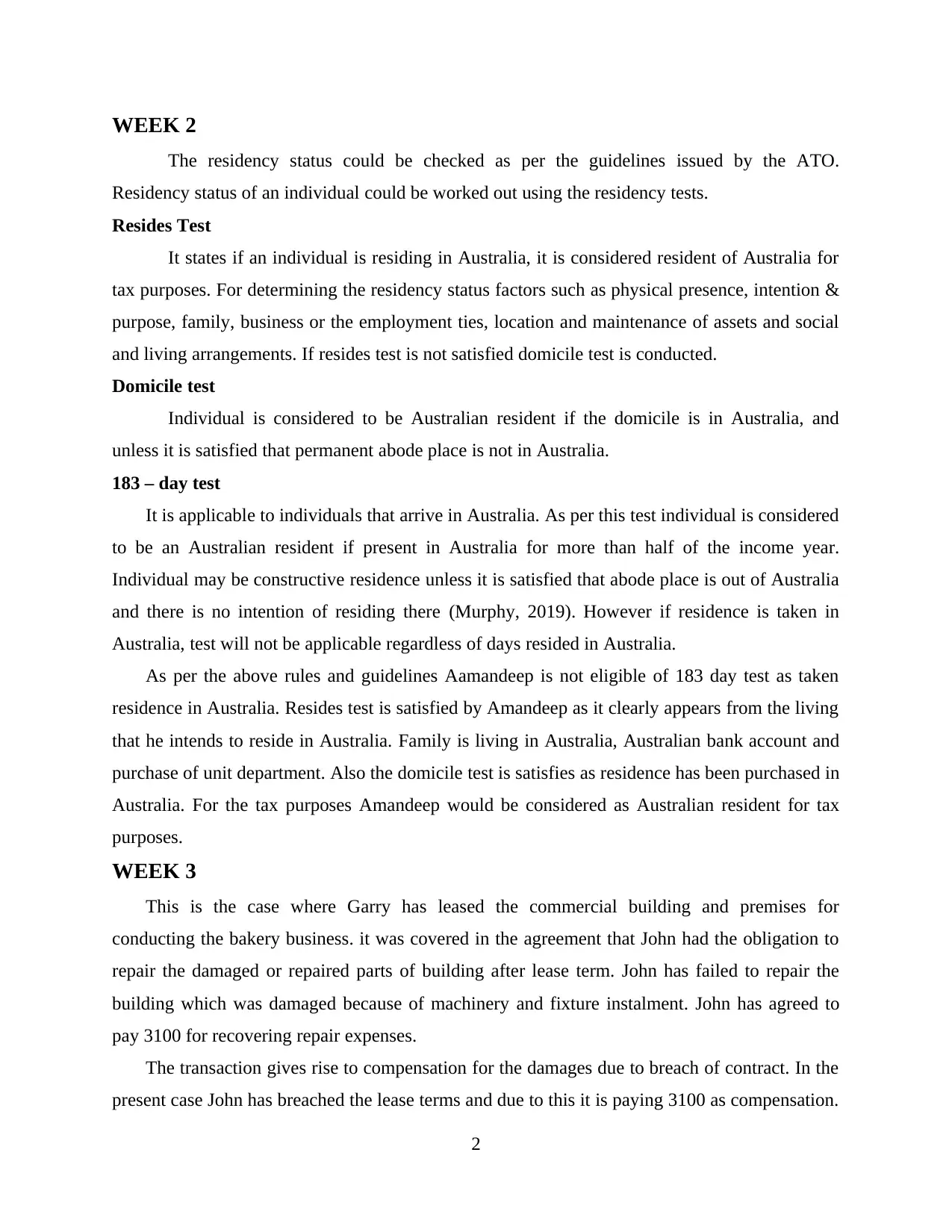
WEEK 2
The residency status could be checked as per the guidelines issued by the ATO.
Residency status of an individual could be worked out using the residency tests.
Resides Test
It states if an individual is residing in Australia, it is considered resident of Australia for
tax purposes. For determining the residency status factors such as physical presence, intention &
purpose, family, business or the employment ties, location and maintenance of assets and social
and living arrangements. If resides test is not satisfied domicile test is conducted.
Domicile test
Individual is considered to be Australian resident if the domicile is in Australia, and
unless it is satisfied that permanent abode place is not in Australia.
183 – day test
It is applicable to individuals that arrive in Australia. As per this test individual is considered
to be an Australian resident if present in Australia for more than half of the income year.
Individual may be constructive residence unless it is satisfied that abode place is out of Australia
and there is no intention of residing there (Murphy, 2019). However if residence is taken in
Australia, test will not be applicable regardless of days resided in Australia.
As per the above rules and guidelines Aamandeep is not eligible of 183 day test as taken
residence in Australia. Resides test is satisfied by Amandeep as it clearly appears from the living
that he intends to reside in Australia. Family is living in Australia, Australian bank account and
purchase of unit department. Also the domicile test is satisfies as residence has been purchased in
Australia. For the tax purposes Amandeep would be considered as Australian resident for tax
purposes.
WEEK 3
This is the case where Garry has leased the commercial building and premises for
conducting the bakery business. it was covered in the agreement that John had the obligation to
repair the damaged or repaired parts of building after lease term. John has failed to repair the
building which was damaged because of machinery and fixture instalment. John has agreed to
pay 3100 for recovering repair expenses.
The transaction gives rise to compensation for the damages due to breach of contract. In the
present case John has breached the lease terms and due to this it is paying 3100 as compensation.
2
The residency status could be checked as per the guidelines issued by the ATO.
Residency status of an individual could be worked out using the residency tests.
Resides Test
It states if an individual is residing in Australia, it is considered resident of Australia for
tax purposes. For determining the residency status factors such as physical presence, intention &
purpose, family, business or the employment ties, location and maintenance of assets and social
and living arrangements. If resides test is not satisfied domicile test is conducted.
Domicile test
Individual is considered to be Australian resident if the domicile is in Australia, and
unless it is satisfied that permanent abode place is not in Australia.
183 – day test
It is applicable to individuals that arrive in Australia. As per this test individual is considered
to be an Australian resident if present in Australia for more than half of the income year.
Individual may be constructive residence unless it is satisfied that abode place is out of Australia
and there is no intention of residing there (Murphy, 2019). However if residence is taken in
Australia, test will not be applicable regardless of days resided in Australia.
As per the above rules and guidelines Aamandeep is not eligible of 183 day test as taken
residence in Australia. Resides test is satisfied by Amandeep as it clearly appears from the living
that he intends to reside in Australia. Family is living in Australia, Australian bank account and
purchase of unit department. Also the domicile test is satisfies as residence has been purchased in
Australia. For the tax purposes Amandeep would be considered as Australian resident for tax
purposes.
WEEK 3
This is the case where Garry has leased the commercial building and premises for
conducting the bakery business. it was covered in the agreement that John had the obligation to
repair the damaged or repaired parts of building after lease term. John has failed to repair the
building which was damaged because of machinery and fixture instalment. John has agreed to
pay 3100 for recovering repair expenses.
The transaction gives rise to compensation for the damages due to breach of contract. In the
present case John has breached the lease terms and due to this it is paying 3100 as compensation.
2
Paraphrase This Document
Need a fresh take? Get an instant paraphrase of this document with our AI Paraphraser
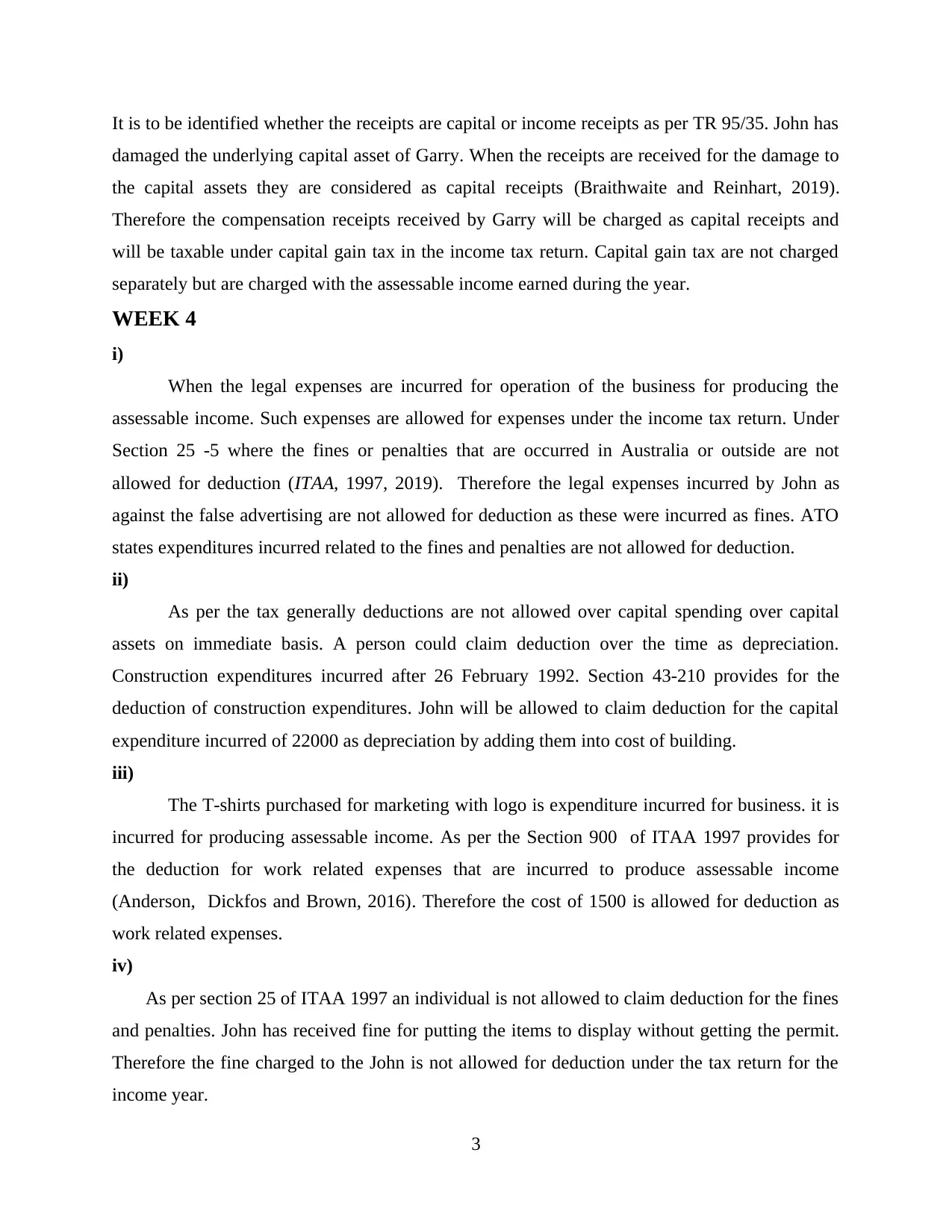
It is to be identified whether the receipts are capital or income receipts as per TR 95/35. John has
damaged the underlying capital asset of Garry. When the receipts are received for the damage to
the capital assets they are considered as capital receipts (Braithwaite and Reinhart, 2019).
Therefore the compensation receipts received by Garry will be charged as capital receipts and
will be taxable under capital gain tax in the income tax return. Capital gain tax are not charged
separately but are charged with the assessable income earned during the year.
WEEK 4
i)
When the legal expenses are incurred for operation of the business for producing the
assessable income. Such expenses are allowed for expenses under the income tax return. Under
Section 25 -5 where the fines or penalties that are occurred in Australia or outside are not
allowed for deduction (ITAA, 1997, 2019). Therefore the legal expenses incurred by John as
against the false advertising are not allowed for deduction as these were incurred as fines. ATO
states expenditures incurred related to the fines and penalties are not allowed for deduction.
ii)
As per the tax generally deductions are not allowed over capital spending over capital
assets on immediate basis. A person could claim deduction over the time as depreciation.
Construction expenditures incurred after 26 February 1992. Section 43-210 provides for the
deduction of construction expenditures. John will be allowed to claim deduction for the capital
expenditure incurred of 22000 as depreciation by adding them into cost of building.
iii)
The T-shirts purchased for marketing with logo is expenditure incurred for business. it is
incurred for producing assessable income. As per the Section 900 of ITAA 1997 provides for
the deduction for work related expenses that are incurred to produce assessable income
(Anderson, Dickfos and Brown, 2016). Therefore the cost of 1500 is allowed for deduction as
work related expenses.
iv)
As per section 25 of ITAA 1997 an individual is not allowed to claim deduction for the fines
and penalties. John has received fine for putting the items to display without getting the permit.
Therefore the fine charged to the John is not allowed for deduction under the tax return for the
income year.
3
damaged the underlying capital asset of Garry. When the receipts are received for the damage to
the capital assets they are considered as capital receipts (Braithwaite and Reinhart, 2019).
Therefore the compensation receipts received by Garry will be charged as capital receipts and
will be taxable under capital gain tax in the income tax return. Capital gain tax are not charged
separately but are charged with the assessable income earned during the year.
WEEK 4
i)
When the legal expenses are incurred for operation of the business for producing the
assessable income. Such expenses are allowed for expenses under the income tax return. Under
Section 25 -5 where the fines or penalties that are occurred in Australia or outside are not
allowed for deduction (ITAA, 1997, 2019). Therefore the legal expenses incurred by John as
against the false advertising are not allowed for deduction as these were incurred as fines. ATO
states expenditures incurred related to the fines and penalties are not allowed for deduction.
ii)
As per the tax generally deductions are not allowed over capital spending over capital
assets on immediate basis. A person could claim deduction over the time as depreciation.
Construction expenditures incurred after 26 February 1992. Section 43-210 provides for the
deduction of construction expenditures. John will be allowed to claim deduction for the capital
expenditure incurred of 22000 as depreciation by adding them into cost of building.
iii)
The T-shirts purchased for marketing with logo is expenditure incurred for business. it is
incurred for producing assessable income. As per the Section 900 of ITAA 1997 provides for
the deduction for work related expenses that are incurred to produce assessable income
(Anderson, Dickfos and Brown, 2016). Therefore the cost of 1500 is allowed for deduction as
work related expenses.
iv)
As per section 25 of ITAA 1997 an individual is not allowed to claim deduction for the fines
and penalties. John has received fine for putting the items to display without getting the permit.
Therefore the fine charged to the John is not allowed for deduction under the tax return for the
income year.
3
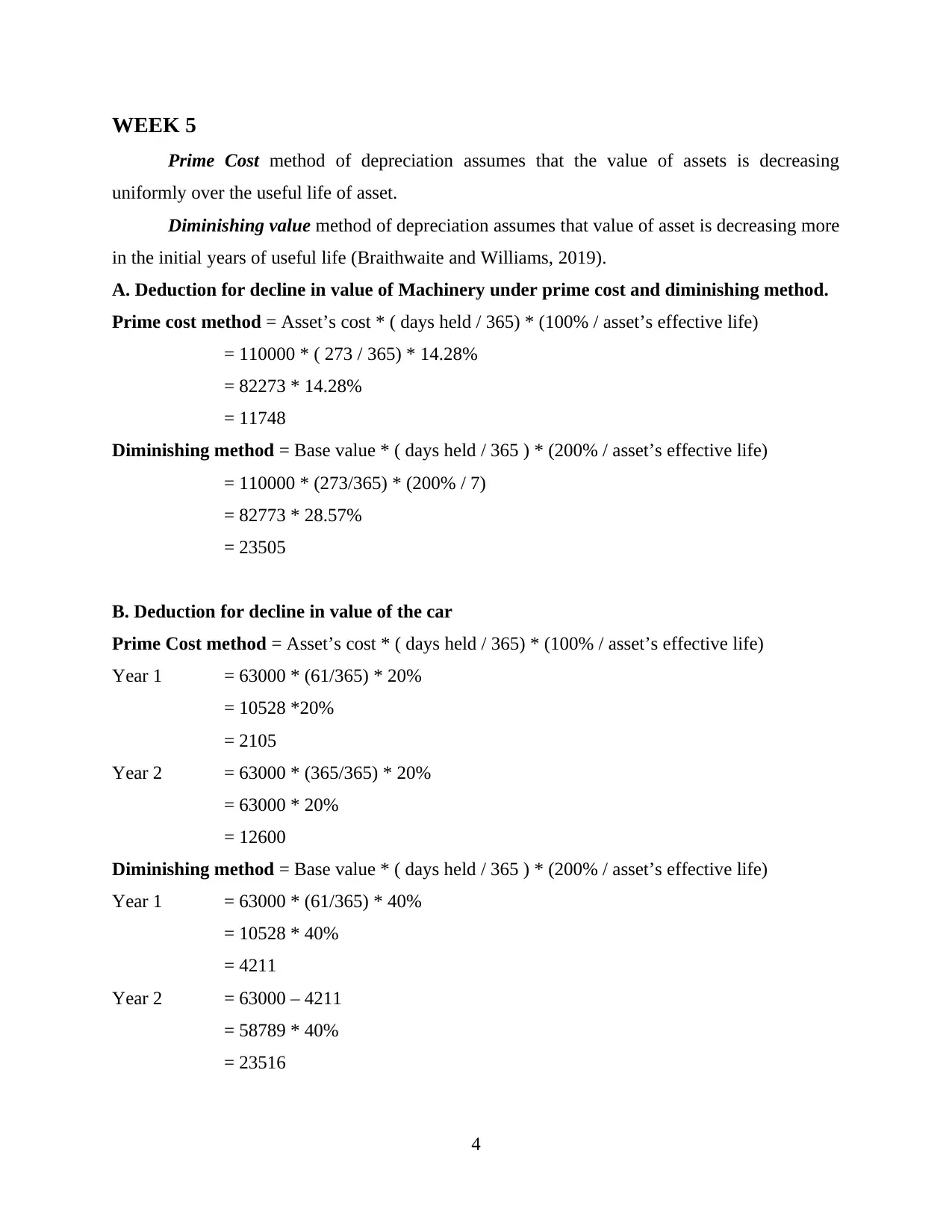
WEEK 5
Prime Cost method of depreciation assumes that the value of assets is decreasing
uniformly over the useful life of asset.
Diminishing value method of depreciation assumes that value of asset is decreasing more
in the initial years of useful life (Braithwaite and Williams, 2019).
A. Deduction for decline in value of Machinery under prime cost and diminishing method.
Prime cost method = Asset’s cost * ( days held / 365) * (100% / asset’s effective life)
= 110000 * ( 273 / 365) * 14.28%
= 82273 * 14.28%
= 11748
Diminishing method = Base value * ( days held / 365 ) * (200% / asset’s effective life)
= 110000 * (273/365) * (200% / 7)
= 82773 * 28.57%
= 23505
B. Deduction for decline in value of the car
Prime Cost method = Asset’s cost * ( days held / 365) * (100% / asset’s effective life)
Year 1 = 63000 * (61/365) * 20%
= 10528 *20%
= 2105
Year 2 = 63000 * (365/365) * 20%
= 63000 * 20%
= 12600
Diminishing method = Base value * ( days held / 365 ) * (200% / asset’s effective life)
Year 1 = 63000 * (61/365) * 40%
= 10528 * 40%
= 4211
Year 2 = 63000 – 4211
= 58789 * 40%
= 23516
4
Prime Cost method of depreciation assumes that the value of assets is decreasing
uniformly over the useful life of asset.
Diminishing value method of depreciation assumes that value of asset is decreasing more
in the initial years of useful life (Braithwaite and Williams, 2019).
A. Deduction for decline in value of Machinery under prime cost and diminishing method.
Prime cost method = Asset’s cost * ( days held / 365) * (100% / asset’s effective life)
= 110000 * ( 273 / 365) * 14.28%
= 82273 * 14.28%
= 11748
Diminishing method = Base value * ( days held / 365 ) * (200% / asset’s effective life)
= 110000 * (273/365) * (200% / 7)
= 82773 * 28.57%
= 23505
B. Deduction for decline in value of the car
Prime Cost method = Asset’s cost * ( days held / 365) * (100% / asset’s effective life)
Year 1 = 63000 * (61/365) * 20%
= 10528 *20%
= 2105
Year 2 = 63000 * (365/365) * 20%
= 63000 * 20%
= 12600
Diminishing method = Base value * ( days held / 365 ) * (200% / asset’s effective life)
Year 1 = 63000 * (61/365) * 40%
= 10528 * 40%
= 4211
Year 2 = 63000 – 4211
= 58789 * 40%
= 23516
4
⊘ This is a preview!⊘
Do you want full access?
Subscribe today to unlock all pages.

Trusted by 1+ million students worldwide
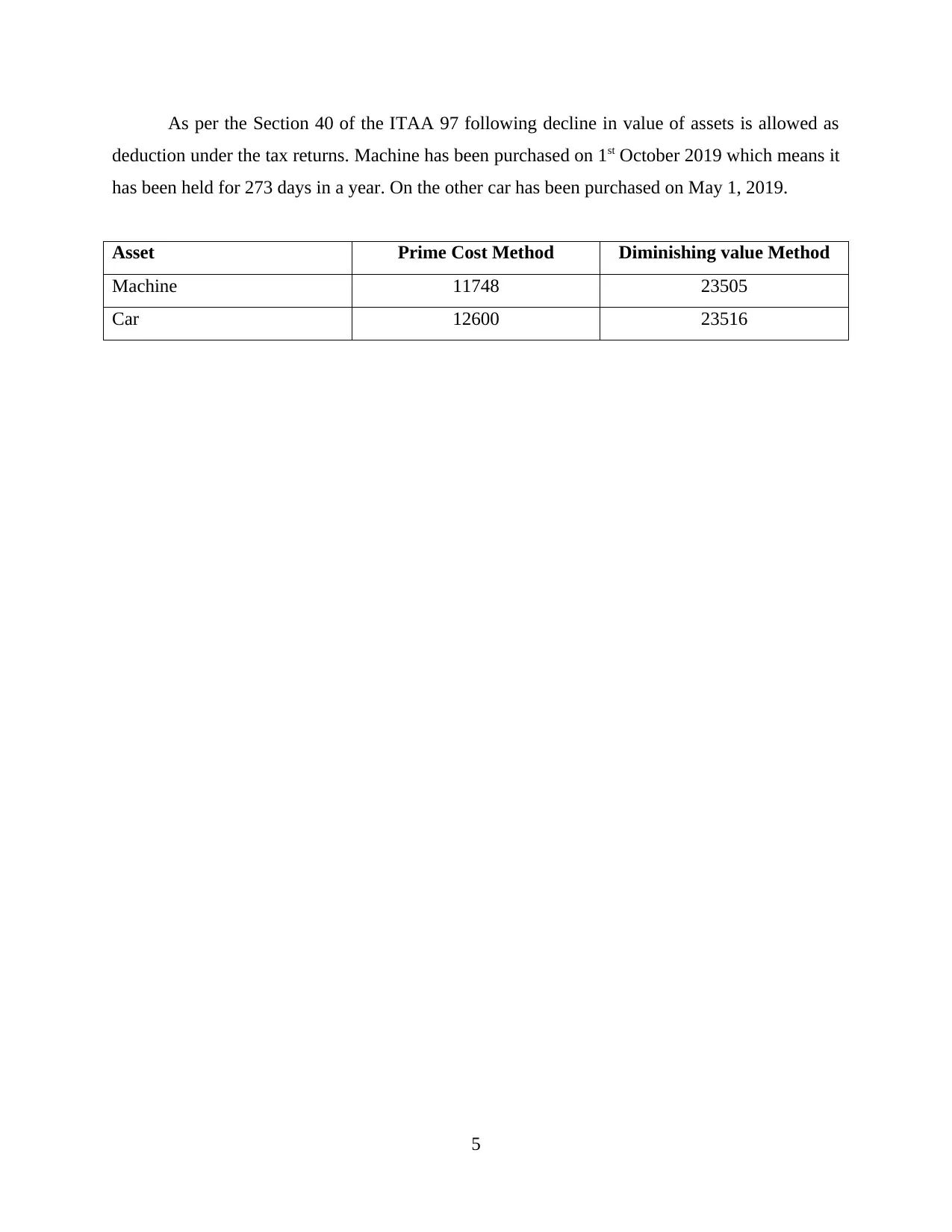
As per the Section 40 of the ITAA 97 following decline in value of assets is allowed as
deduction under the tax returns. Machine has been purchased on 1st October 2019 which means it
has been held for 273 days in a year. On the other car has been purchased on May 1, 2019.
Asset Prime Cost Method Diminishing value Method
Machine 11748 23505
Car 12600 23516
5
deduction under the tax returns. Machine has been purchased on 1st October 2019 which means it
has been held for 273 days in a year. On the other car has been purchased on May 1, 2019.
Asset Prime Cost Method Diminishing value Method
Machine 11748 23505
Car 12600 23516
5
Paraphrase This Document
Need a fresh take? Get an instant paraphrase of this document with our AI Paraphraser

REFERENCES
Books and Journals
Murphy, K., 2019. Procedural justice and the Australian Taxation Office: A study of scheme
investors. Centre for Tax System Integrity (CTSI), Research School of Social Sciences,
The Australian National University.
Woellner, R. And et.al., 2016. Australian Taxation Law 2016. OUP Catalogue.
Braithwaite, V. and Reinhart, M., 2019. The Taxpayers' Charter: Does the Australian Tax Office
comply and who benefits?. Centre for Tax System Integrity (CTSI), Research School of
Social Sciences, The Australian National University.
Anderson, C., Dickfos, J. and Brown, C., 2016. The Australian Taxation Office–what role does it
play in anti-phoenix activity?. Insolvency Law Journal. 24(2). pp.127-140.
Braithwaite, J. and Williams, R., 2019. Meta risk management and tax system integrity. Centre
for Tax System Integrity (CTSI), Research School of Social Sciences, The Australian
National University.
Online
ITAA, 1997. 2019. [Online]. Available through :
<http://classic.austlii.edu.au/au/legis/cth/consol_act/itaa1997240/>.
6
Books and Journals
Murphy, K., 2019. Procedural justice and the Australian Taxation Office: A study of scheme
investors. Centre for Tax System Integrity (CTSI), Research School of Social Sciences,
The Australian National University.
Woellner, R. And et.al., 2016. Australian Taxation Law 2016. OUP Catalogue.
Braithwaite, V. and Reinhart, M., 2019. The Taxpayers' Charter: Does the Australian Tax Office
comply and who benefits?. Centre for Tax System Integrity (CTSI), Research School of
Social Sciences, The Australian National University.
Anderson, C., Dickfos, J. and Brown, C., 2016. The Australian Taxation Office–what role does it
play in anti-phoenix activity?. Insolvency Law Journal. 24(2). pp.127-140.
Braithwaite, J. and Williams, R., 2019. Meta risk management and tax system integrity. Centre
for Tax System Integrity (CTSI), Research School of Social Sciences, The Australian
National University.
Online
ITAA, 1997. 2019. [Online]. Available through :
<http://classic.austlii.edu.au/au/legis/cth/consol_act/itaa1997240/>.
6
1 out of 8
Related Documents
Your All-in-One AI-Powered Toolkit for Academic Success.
+13062052269
info@desklib.com
Available 24*7 on WhatsApp / Email
![[object Object]](/_next/static/media/star-bottom.7253800d.svg)
Unlock your academic potential
Copyright © 2020–2025 A2Z Services. All Rights Reserved. Developed and managed by ZUCOL.





